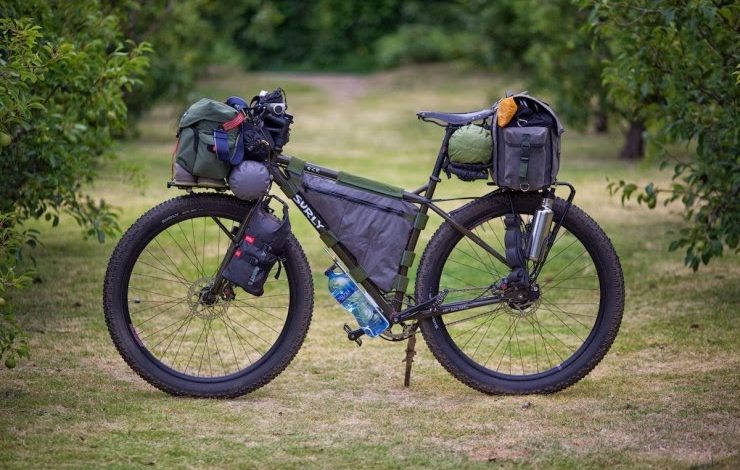What Is The Difference Between Touring And Mountain Bike?

Touring bikes are designed for those traveling by bike over multiple days. Touring bikes are meant to carry lots of gear. Mountain bikes, on the other hand, are designed to travel short distances down mountainsides, rough trails, and over obstacles for a thrilling and exciting ride.
This article will take a close look at the 13 differences between touring bikes and mountain bikes.
And while you might be able to use your mountain bike for traveling, it’s improbable that you would want to bomb down a mountain bike trail on your touring bike.
If you enjoy both types of riding, you’ll want to know the difference between mountain bikes and touring bikes.
What is a Mountain Bike
A mountain bike is a bike designed for bombing through wooded trails, conquering rock gardens, and flying over obstacles.
Mountain bikes aren’t lightweight bikes, but they are rugged and sturdy. They are designed with extra suspension to lessen the impact of the bumps and vibrations of the terrain.
In addition, mountains have responsive steering to get you around obstacles, and they are designed to take a lot of abuse on the trail.
What Is a Touring Bike
A touring bike is a bike designed for traveling by bicycle.
They are comfortably designed for long days in the saddle, experiencing the world and seeing new sights.
They’re also created to carry all your gear, so you can be self-sufficient for as many days as you desire. Touring bikes are made to be sturdy and well-balanced, so you can pile on everything you need for your trip without worrying about steering, pedaling, or stopping.
Although you can technically use a mountain bike as a touring bike, you can’t really use a touring bike like a mountain bike.
They are simply two entirely different types of bikes, each with its own strengths, weaknesses, and unique characteristics.
You can choose the best bike for you if you know what truly makes them different.
What Makes a Mountain Bike Different from a Touring Bike?
1. Purpose
The biggest difference between a mountain bike and a touring bike is their purpose.
A mountain bike is designed for going off-road, grinding over gravel, zipping around rock gardens, bumping over logs, trails, and hopping over obstacles.
Mountain bikes might spin slowly up the hill, but they’re made to fly back down. These rugged bikes are meant to be used by the thrill-seeking adrenaline junkie.
Touring bikes, on the other hand, are made for trips.
They’re designed to be comfortable for long days in the saddle, allowing you to explore towns and cities on the beaten path and off.
These bikes can go off-road, but they won’t be fun on challenging trails like mountain bikes. Instead, they’re made for traveling by road, gravel, and path to take you to new places.
2. Mileage
Mountain bikes aren’t necessarily made to be ridden for lots of miles at a time.
An average mountain bike route is probably only around 10 to 15 miles.
Mountain bike riding is very technical riding. You need to choose the right line to get around or over obstacles. You need to jump, hop, and be able to ride slow.
Because of the physical and mental demands of mountain biking, you aren’t going to go for very long rides.
Bike touring, on the other hand, is not nearly as technical as mountain biking. And while you may go over some gravel or trails, the ride won’t be quite as demanding on your skills.
Bike touring trips can easily last 40 to 60 or more miles per day for multiple days.
For this reason, touring bikes are designed for longer, easier miles in the saddle as compared to the shorter, harsher miles on the mountain bike.
3. Handlebars
Mountain bikes generally have wide, flat bars for optimum leverage.
Unfortunately, they don’t give you many options for hand position, but it doesn’t matter as much since mountain bike rides are typically shorter.
Touring bikes, on the other hand, come in a variety of bar types. You might have flat bars, but you also might have a touring bike with drop bars or even more upright bars for comfort.
Drop bars are optimum on touring bikes, though, since they give you so many hand and body positions to choose from.
Some touring bikes even come with adapted TT bars to provide you with another way to stretch out in the saddle.
4. Gears
There can be a big difference in gear choices for mountain bikes versus touring bikes.
On the one hand, mountain bikes typically have a 1x drivetrain.
This means there is only one chainring in the front but a variety of cogs in the back.
On the other hand, mountain bikes don’t really have to be concerned about keeping the optimum cadence to prevent leg fatigue. They need an easy gear to get up the hill and a few different gears to come back down.
A 1x drivetrain is simpler, lighter, and requires a little less maintenance than a standard drivetrain.
It also means fewer parts to catch on obstacles, tree branches, and weeds.
Touring bikes, on the other hand, will have more gears. They will usually have two chainrings in the front and a variety of cogs in the back.
This gives the rider more gears to choose from to keep a comfortable cadence for longer trips to prevent fatigue. It also means more easy gears to get up hills with lots of cargo and some harder gears to go faster on flat roads.
And a 2x drivetrain means it is easy to keep up with the other folks on your trip.
5. Geometry
Both touring and mountain bikes have a little more relaxed geometry than a road or a cyclocross bike. (Source)
However, mountain bikes still need very responsive steering to get around obstacles quickly and without crashing.
Touring bikes will have even more relaxed geometry than mountain bikes will have. The bike itself will probably be even longer to give it more stability for carrying cargo, and the bars maybe even more upright for extra comfort.
6. Suspension
Mountain bikes have a variety of suspension options. Depending on the type of trail you ride, you might want a hardtail, rigid, or dual suspension.
The more bumps and jumps, the more suspension you need. The easier the trail, the less suspension you need.
Touring bikes, however, don’t have any special source of suspension. Both bikes will get a little bit of cushion from the wider tires, and touring bikes will bring more comfort from the steel frames.
7. Dropper Post
A dropper post will quickly and easily drop your seat out of the way to give you more room to maneuver over obstacles.
Since touring bikes don’t have to carve a path through rock gardens or gnarly roots, they don’t typically have dropper posts like mountain bikes do.
The 1x drivetrain on the mountain bike also leaves an extra shifter lever available to operate the dropper post.
8. Frame Material
Frame material makes a big difference in the price of your bike as well as the ride quality.
For touring bikes, steel seems to be the most popular choice. Not only is it a little less expensive than, say, carbon, it’s also a lot more comfortable to ride for extended distances, making it ideal for a touring bike.
On the other hand, mountain bikes are available in various frame materials from super-light carbon to snappy aluminum, and yes, even steel.Carbon fiber seems to be the most popular for mountain bike racing, though.
9. Wheels
The wheels on a touring bike are generally 700C wheels with a width of 25 to 42mm—the wider the tire, the more comfortable the ride.
If you take your touring bike on asphalt roads, you can easily get by with a standard 25mm tire. However, if you will hit some gravel or some trails with your touring bike, you’ll want to lean more towards the higher end.
Mountain bike wheels are a different matter, though. They tend to be smaller and even fatter than touring bike wheels.
As a result, you’ll find mountain bike wheels in various sizes: 26 inches, 650b, and 29.
Unfortunately, while 29ers are pretty popular, they don’t do well on pump tracks.
650bs can be used on both touring bikes and mountain bikes for a cushier ride with extra grip.
10. Cargo
Mountain bikes aren’t designed to carry cargo.
Since they’re meant for shorter trips, you probably won’t fit much more on them than a couple of water bottles and a saddlebag. Many don’t even have a top tube, so frame bags and top tube bags are out of the question.
You might not be able to fit a handlebar bag either due to the shape of the bars and the location of the brakes levers. And unless you use a clamp-style cargo rack, you won’t have a spot for that, either.
Finally, your storage space is simply very limited on a mountain bike.
On the other hand, though, touring bikes are meant to carry a lot of gear.
Since touring bikes are designed to be ridden for multiple-day trips, you’ll find multiple places to stash your stuff.
Braze-ons are mounts integrated into the bike to allow you to attach gear directly to the bike. So you can easily connect your cargo rack, top tube bag, frame bag, downtube bag, panniers, front fork panniers, and handlebar bags.
You can even attach a cargo cart, pet cart, or kid cart so you can pull your family, your canine buddy, or more gear.
There are many options to fit cargo onto your bike, and with its extra gears, it is designed to make it uphill no matter how loaded down you are.
The extra stability of a touring bike means you can load it up without worrying about losing steering ability, too.
11. Fenders
Mountain bikes don’t have spots for fenders. This is because fenders could easily get caught on branches, rocks, or other obstacles, causing a hazardous situation for you and your bicycle.
Touring bikes not only have spots for fenders but they are also often included in the package.
Fenders will help prevent mud and dirt from spraying up from behind, covering you and your gear with mud and muck.
12. Shifters
Since mountain bikes have flat bars, they have a unique type of shifter.
Older mountain bikes have grip shifters, where you turn the grip on the end of the handlebars. More modern mountain bikes have trigger shifters, where you trigger the shift with your thumb or finger.
Many touring bikes have drop bars to give you more hand and body positions for long days in the saddle. Since they have drop bars, the shifters will be levers integrated with the brakes on the hoods of the bars.
13. Lights
Mountain bikes don’t usually have rear lights since they are typically ridden on trails and not roads.
You may have a front light on a mountain bike if you are riding at night, though.
Touring bikes should have both front and rear lights since they are often ridden on roads where traffic could be challenging.
What Makes Mountain Bikes and Touring Bikes Similar?
Weight
Neither mountain bikes nor touring bikes are lightweight like a road bike can be.
However, these bikes aren’t designed for pure speed, so weight is much less of a factor than it would be with a road bike.
And what these bikes lack in being lightweight, they make up for in gearing. Since both types of bikes are heavier, they have very easy gears to get up steep hills.
Wider, Cushier Tires
Although the wheels on both types of bikes are different, they are similar in that they have more grip than a standard road tire, are a little wider, and are a lot cushier to take out some of the vibrations and bumps.



